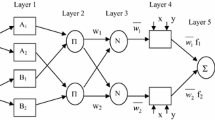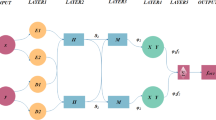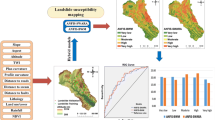Abstract
A GIS-based hybrid neuro-fuzzy approach to mineral potential mapping implements a Takagi–Sugeno type fuzzy inference system in a four-layered feed-forward adaptive neural network. In this approach, each unique combination of predictor patterns is considered a feature vector whose components are derived by knowledge-based ordinal encoding of the constituent predictor patterns. A subset of feature vectors with a known output target vector (i.e., unique conditions known to be associated with either a mineralized or a barren location), extracted from a set of all feature vectors, is used for the training of an adaptive neuro-fuzzy inference system. Training involves iterative adjustment of parameters of the adaptive neuro-fuzzy inference system using a hybrid learning procedure for mapping each training vector to its output target vector with minimum sum of squared error. The trained adaptive neuro-fuzzy inference system is used to process all feature vectors. The output for each feature vector is a value that indicates the extent to which a feature vector belongs to the mineralized class or the barren class. These values are used to generate a favorability map. The procedure is applied to regional-scale base metal potential mapping in a study area located in the Aravalli metallogenic province (western India). The adaptive neuro-fuzzy inference system demarcates high favorability zones occupying 9.75% of the study area and identifies 96% of the known base metal deposits. This result is significant both in terms of reduction in search area and the percentage of deposits identified.
Similar content being viewed by others
REFERENCES
Bonham-Carter, G. F., and Agterberg, F. P., 1990, Application of a microcomputer-based geographic information system to mineral-potential mapping, in Hanley, J. T., and Merriam, D. F., eds., Microcomputer-based applications in geology, II, Petroleum: Pergamon, New York, p. 49–74.
Bonissone, P. P., and Decker, K., 1986, Selecting uncertainty calculi and granularity: An experiment in trading-off precision and complexity, in Kanal, L. N. and Lemmer, J. F., eds., UAI '85: Proceedings of the First Annual Conference on Uncertainty in Artificial Intelligence, 10–12 July 1985, Rome, New York, USA, Elsevier Science, Amsterdam, p. 217–247.
Cheng, Q., and Agterberg, F. P., 1999, Fuzzy weights of evidence and its application in mineral potential mapping: Nat. Resour. Res., v. 8, no. 1, p. 27–35.
Davis, J. C., 1986, Statistics and data analysis in geology: Wiley, New York, 646 p.
Deb, M., 2000, VMS deposits: Geological characteristics, genetic models and a review of their metal-logenesis in the Aravalli range, NW India, in Deb, M., ed., Crustal evolution and metallogeny in the Northwestern Indian Shield: Narosa, New Delhi, p. 217–239.
Deb, M., and Sarkar, S. C., 1990, Proterozoic tectonic evolution and metallogenesis in the Aravalli–Delhi orogenic complex, NW India: Precambrian Res., v. 46, p. 115–137.
Goguen, J. A., 1969, The logic of inexact concepts: Synthese, v. 19, p. 325–373.
Goodfellow, W. D., 2001, Attributes of modern and ancient sediment-hosted, seafloor hydrothermal Deposits, in Deb, M. and Goodfellow, W. D., eds., Workshop Proceedings Sediment Hosted Lead-Zinc Sulphide Deposits in the Northwestern Indian, UNESCO-IUGS Deposit Modeling Program, UNESCO, Paris, p.1–35.
GSI, 1981, Total intensity aeromagnetic map and map showing the magnetic zones of the Aravalli region, southern Rajasthan and northwestern Gujarat, India (1:253,440): Geological Survey of India, Hyderabad, India.
Gupta, S. N., Arora, Y. K., Mathur, R. K., Iqballuddin, Prasad, B., Sahai, T. N., and Sharma, S. B., 1995a, Lithostratigraphic map of Aravalli region, 2nd edn. (1:250,000): Geological Survey of India, Calcutta, India.
Gupta, S. N., Arora, Y. K., Mathur, R. K., Iqballuddin, Prasad, B., Sahai, T. N., and Sharma, S. B., 1995b, Structural map of the Precambrian of Aravalli region, 2nd edn. (1:250,000): Geological Survey of India, Calcutta, India.
Gupta, S. N., Arora, Y. K., Mathur, R. K., Iqballuddin, Prasad, B., Sahai, T. N., and Sharma, S. B., 1997, The Precambrian geology of the Aravalli Region, Memoir, v. 123: Geological Survey of India: Calcutta, India: 262 p.
Haldar, S. K., 2001, Grade-tonnage model for lead-zinc deposits of Rajasthan, India, in Deb, M. and Goodfellow, W. D., eds., Workshop Proceedings, Sediment Hosted Lead-Zinc sulphide De-posits in the Northwestern Indian, UNESCO-IUGS Deposit Modeling Program, UNESCO, Paris, p. 153–160.
Heron, A. M., 1953, The geology of central Rajputana, Memoir, v, 79, no 1: Geological Survey of India: Calcutta, India: 389 p.
Jang, J. S. R., 1993, ANFIS: Adaptive-network-based fuzzy inference system: IEEE Trans. Syst., Man Cybern., v. 23, p. 665–685.
Jang, J. S. R., and Sun, C. T., 1995, Neuro-fuzzy modelling and control: Proc. IEEE, v. 83, p. 378–406.
Mamdani, E. H., 1974, Applications of fuzzy algorithm for control of a simple dynamic plant: Proc. IEEE, v. 121, no. 12, p. 1585–1588.
Mamdani, E. H., and Assilian, S., 1975, An experiment in linguistic synthesis with a fuzzy logic controller: Int. J. Man-Machine Stud., v. 7, no. 1, p. 1–13.
Menzie, W. D., and Mosier, D. L., 1986, Grade and tonnage model of sedimentary exhalative Zn-Pb, in Cox, D. P., and Singer, D. A., eds., Mineral deposit models: U.S. Geological Survey Bulletin No. 1693, p. 212–215.
Mizumoto, M., 1989, Pictorial representations of fuzzy connectives, Part I: Cases of T-norms, T-conorms and averaging operators: Fuzzy Sets Syst., v. 31, p. 217–242.
Porwal, A., Carranza, E. J. M., and Hale, M., 2003, Knowledge-driven and data-driven fuzzy models for predictive mineral potential mapping: Nat. Resour. Res., v. 12, no. 1, p. 1–25.
Raja Rao, C. S., Poddar, B. C., Basu, K. K., and Dutta, A. K., 1971, Precambrian stratigraphy of Rajasthan: A review records, v. 101, no. 2: Geological Survey of India: p. 60–79.
Roy, A. B., 1988, Stratigraphic and tectonic framework of the Aravalli Mountain Range, in Roy, A. B., ed., Precambrian of the Aravalli Mountain Rajasthan, India, Memoir, v. 7: Geological Society of India: p. 3–31.
Roy, A. B., Sharma, B. L., Paliwal, B. S., Chauhan, N. K., Nagori, D. K., Golani, P. R., Bejarniya, B. R., Bhu, H., and Ali Sabah, M., 1993, Lithostratigraphic and tectonic evolution of the Aravalli Supergroup: a protogeosynclinal sequence, in Cassyap, A. M. (ed.), Rift basins and aulacogens: Gyanodaya Prakashan, Nainital, p. 73–90.
Rumelhart, D. E., Hinton, G. E., and Williams, R. J., 1986, Learning internal representations by error propagation, in Rumelhart, D. E., and McClelland, J. L. (eds.), Parallel distributed processing: Explorations in the microstructure of cognition, Vol. 1, Foundations: MIT Press, Cambridge, p. 318–362.
Sudgen, T. J., Deb, M., and Windley, B. F., 1990, The tectonic setting of mineralization in the Proterozoic Aravalli-Delhi orogenic belt, NWIndia, in Naqvi, S. M., ed., Precambrian continental crust and its economic resources: Elsevier, Amsterdam, p. 367–390.
Sugeno, M., and Kang, G. T., 1988, Structure identification of fuzzy model: Fuzzy Sets Syst., v. 28, p. 12–33.
Sugeno, M., and Tanaka, K., 1991, Successive identification of a fuzzy model and its application to prediction of complex systems: Fuzzy Sets Syst., v. 42, p. 315–334.
Takagi, T., and Sugeno, M., 1985, Fuzzy identification of systems and its applications to modeling and control: IEEE Trans. Syst., Man Cybern., v. 15, no. 1, p. 116–132.
Tsukamoto, Y., 1979, An approach to fuzzy reasoning method, in Gupta, M. M., Ragade, R. K., and Yager, R. R., eds., Advances in fuzzy set theory and applications: North-Holland, Amsterdam, p. 137–149.
Wang, C., Venkatesh, S. S., and Judd, J. S., 1994, Optimal stopping and effective machine complexity in learning, in Cowan, J. D., Tesauro, G., and Alspector, J., eds., Advances in neural information processing systems: Morgan Kaufmann, San Francisco, p. 303–310.
Zadeh, L. A., 1971, Similarity relations and fuzzy orderings: Inf. Sci., v. 3, p. 177–206.
Zadeh, L. A., 1973, Outline of a new approach to the analysis of complex systems and decision process: IEEE Trans. Syst., Man Cybern., v. 3, p. 28–44.
Zimmermann, H. J., 1991, Fuzzy set theory—and its applications: Kluwer Academic, Dordrecht, The Netherlands, 399 p.
Author information
Authors and Affiliations
Rights and permissions
About this article
Cite this article
Porwal, A., Carranza, E.J.M. & Hale, M. A Hybrid Neuro-Fuzzy Model for Mineral Potential Mapping. Mathematical Geology 36, 803–826 (2004). https://doi.org/10.1023/B:MATG.0000041180.34176.65
Issue Date:
DOI: https://doi.org/10.1023/B:MATG.0000041180.34176.65




